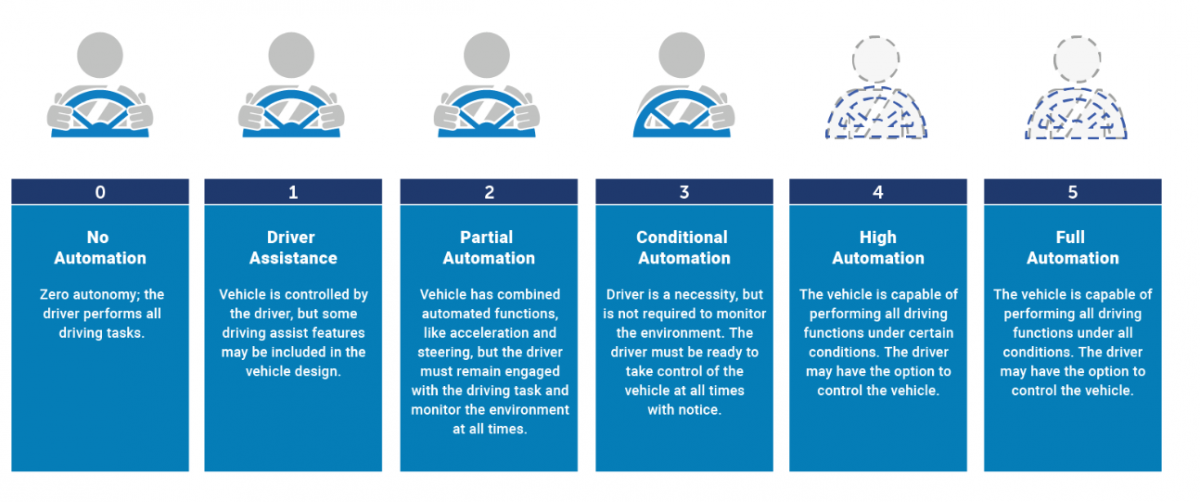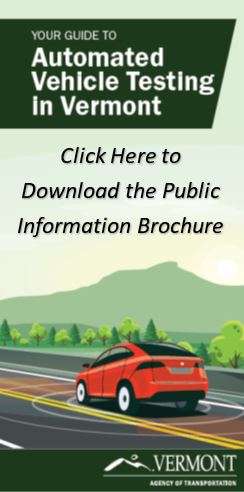This website describes the permitting process required to test an automated vehicle on state and town highways in Vermont. It provides a link to the Vermont Automated Vehicle Testing Permit Guidance and Application and provides general information about automated vehicles. There are currently no permit applications under consideration. Information about specific permit applications and testing will be provided on the site in the future.
Vermont AV-Xchange Forum
VTrans hosted the first ever VT Automated Vehicle Xchange on February 8, 2021. The virtual forum was a candid and informative discussion around opportunities and challenges for testing AVs in Vermont. Speakers included the Vermont Secretary of Transportation and representatives from May Mobility, TuSimple, EasyMile, George Washington University, Village of Bellows Falls, Town of Rockingham, Town of Springfield, Vermont League of Cities and Towns, and the Chittenden County Regional Planning Commission.
A video of the AV-Xchange Forum is available here: https://youtu.be/LammYmD3Kl4
Automated Vehicle Testing Permit Guidance and Application
The Guide implements the 2019 Automated Vehicle Testing Act and describes the process and requirements to obtain a permit to test automated vehicles on state and town highways in Vermont. The Guide is intended for use by applicants who are seeking a permit to test automated vehicles on public roads in Vermont and municipalities that are considering allowing testing on town highways under their jurisdiction. It also serves as a guide to the Vermont Traffic Committee, whose approval is required for all automated vehicle test permits in the state, in its deliberations over specific permit applications.
The Guide was approved by the Traffic Committee at a public hearing on October 15th, 2020. The presentation, video and minutes from the public hearing are provide below.
Why Allow Testing on Vermont Roads?
See the AV Testing in Vermont Video: https://www.youtube.com/watch?v=Ohz3FjqGuBw
Opinions vary about the time it will take for automated vehicles to be deployed and in use by the general public. One forecast suggests that vehicles with some level of automation will increase to 40-60% of all vehicles on the road by 2050[2]. A more assertive forecast suggests that 95% of passenger miles travelled will be in automated vehicles by 2030[3]. Vermont needs to prepare for automated vehicles, which have the potential to improve safety, increase mobility for people who cannot currently drive, and reduce travel costs for Vermont households, businesses, and visitors. Like computers and smart phones, automated vehicles will become increasingly important to our economic vitality. Testing in Vermont will help build public confidence that automated driving systems are feasible in our rural, cold, hilly state, and along our famous “dirt” roads. Testing will also provide an opportunity for law enforcement, emergency responders, road crews, engineers, transit operators, and other stakeholders to learn and gain experience with the technology.
Overview of the Vermont Automated Vehicle Testing Act
Vermont’s Automated Vehicle Testing Act (“AV Testing Act”) became law in June 2019 (23 VSA Chapter 41) and creates a permitting process to allow the testing of automated vehicles, often referred to as self-driving cars, on state and town highways. A testing permit is required from the Traffic Committee, whose members are the Secretary of Transportation, Commissioner of Motor Vehicles, and Commissioner of Public Safety. The Traffic Committee is authorized to issue testing permits for the state highway system, class 1 town highways which are the continuation of US and state numbered routes through municipalities, and class 2, 3, and 4 town highways in municipalities that have pre-approved testing on their roads.
Automated Vehicles Overview: Equipment, Systems and Why Test in Vermont.
Automated vehicles are equipped with an automated driving system (ADS) that enables them to operate with little to no human assistance, with the use of cameras, radar, lidar (image sensing), GPS, and computer vision to sense their surroundings. ADS can carry out the real-time dynamic driving tasks required to operate a vehicle in on-road traffic. There are five levels of automation, and a permit from the Vermont Traffic Committee is required to test vehicles on state and town highways with level 3, 4, or 5 automation (highly automated).

Figure 1: Levels of Driving Automation[1]
The Systems Behind Autonomous Vehicles
- CAMERAS Provide a 360-degree view to detect traffic lights and road signs
- LIDAR Laser scanner used to map surroundings in high definition
- ARTICULATING RADARS Scan a wide field to monitor position of vehicles, pedestrians, objects
- SHORT-RANGE RADAR Detects objects, pedestrians, vehicles near the car
- LONG-RANGE-RADAR Measures speed of traffic down the road
- VEHICLE LOCATION Information gathered from sensors plus GPS data determine the vehicle’s precise location
- HIGH-SPEED PROCESSORS Crunch data from sensors to direct the cars movements.
Sources of additional information on automated vehicles are provided below.
Preparing for Automated Vehicles in Vermont, A Report to the Vermont General Assembly https://legislature.vermont.gov/assets/Legislative-Reports/2017-Act-38-Sec-15-Automated-Vehicles-Report-to-Legislature-Jan-15-2018.pdf
National Highway Traffic Safety Administration https://www.nhtsa.gov/technology-innovation/automated-vehicles-safety
National League of Cities Autonomous Vehicle Pilots Across America, 2018. https://www.nlc.org/sites/default/files/2018-10/AV%20MAG%20Web.pdf
National Association of Counties. Connected and Automated Vehicle Tool Kit. https://www.naco.org/resources/featured/connected-autonomous-vehiclestoolkit#link-1
[2] See Figure 5, page 15 “Preparing for Automated Vehicles: Traffic Safety Issues for States”. Governor’s Highway Safety Association, https://www.ghsa.org/sites/default/files/2018-08/Final_AVs2018.pdf
[3] Rethinking Transportation 2020-2030 The Disruption of Transportation and the Collapse of the Internal-Combustion Vehicle and Oil Industry”, RethinkX, May 2017; https://www.rethinkx.com/transportation

